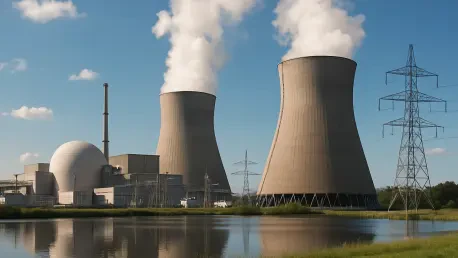Setting the Stage for a Nuclear Resurgence
The nuclear energy sector in the United States stands at a pivotal juncture, with soaring electricity demands from data centers and manufacturing hubs pushing the boundaries of current capacity. Amid this challenge, a staggering $80 billion investment by the U.S. government into Westinghouse, a historic nuclear technology firm, signals a potential game-changer for the industry. This financial commitment, backed by the Trump administration’s vision for energy independence, aims to catalyze the construction of nuclear power plants nationwide. The deal, forged with Westinghouse’s owners—Cameco, a prominent uranium miner, and Brookfield Asset Management, a key energy investor—could even see the government holding an 8% stake in the company by January 2029, contingent on a valuation of at least $30 billion. This analysis explores the market dynamics, technological trends, and strategic implications of this bold move, assessing whether Westinghouse can spearhead a nuclear revival and reshape the energy landscape.
Unpacking the Nuclear Market: Trends, Data, and Insights
Policy Push and Financial Backing: A Catalyst for Growth
The U.S. nuclear energy market is witnessing an unprecedented level of governmental involvement, driven by the urgent need to address escalating power demands. The Trump administration’s executive order to build 10 large nuclear reactors by 2030 reflects a strategic focus on expanding capacity through nuclear solutions. With the $80 billion investment, facilitated by the Commerce Department, the government is not merely providing funds but also positioning itself as a stakeholder in Westinghouse’s future. This financial backing, supplemented by Department of Energy loans and jurisdictional financing, aims to rejuvenate a sector that has stagnated due to high costs and public skepticism. Market data suggests that nuclear energy could account for a significant portion of new capacity if projects are executed on time, though historical cost overruns remain a persistent concern.
Technological Edge: The Role of the AP1000 Reactor
At the core of Westinghouse’s market strategy lies the AP1000 reactor, a design capable of generating a gigawatt of electricity, sufficient to power over 750,000 homes. This technology, with its advanced passive safety features, positions Westinghouse as a potential leader in modern nuclear solutions. Recent project completions in Georgia demonstrate the reactor’s feasibility, yet past failures, such as a canceled initiative in South Carolina, underscore the risks of delays and budget excesses. Industry projections indicate that large-scale orders, supported by government contracts, could stabilize costs through economies of scale. If successful over the next few years, the AP1000 could redefine the competitive landscape, though execution remains the critical variable in market acceptance.
Stakeholder Strategies and Market Flexibility
The strategic maneuvers of Westinghouse’s parent companies, Cameco and Brookfield Asset Management, add another dimension to this market analysis. Flexibility in decision-making is evident, with options for an initial public offering (IPO) or a spinoff of Westinghouse as an independent entity by 2029 hinging on valuation and market conditions. This pragmatic approach ensures that stakeholders can adapt to economic shifts and investor sentiment. Regional disparities also influence market dynamics, as states with high energy needs may prioritize nuclear projects more aggressively than others. Contrary to lingering misconceptions, nuclear energy can be profitable with the right scale and policy support, a perspective gaining traction among industry leaders. The alignment of public and private interests will be pivotal in navigating these complexities.
Emerging Trends and Future Projections
Looking toward the end of the decade, several trends are poised to shape the nuclear energy market. The insatiable electricity demands from data centers and industrial sectors are driving a renewed focus on reliable, carbon-neutral power sources like nuclear. Technological innovations, including small modular reactors (SMRs), could complement Westinghouse’s offerings, providing scalable solutions for diverse regions. Regulatory reforms, such as streamlined permitting processes, may accelerate project timelines, though economic uncertainties and public perception of safety remain challenges. Analysts project that achieving a $30 billion valuation by 2029 could trigger an IPO, attracting further private investment. Success in this arena might establish the U.S. as a global leader in nuclear innovation, provided current momentum translates into tangible results.
Reflecting on the Path Forward: Strategic Implications
Looking back, the analysis of Westinghouse’s potential to lead an $80 billion nuclear revival reveals a market at a crossroads, balancing immense opportunity with historical hurdles. The government’s substantial financial and strategic support has set a foundation for growth, while the AP1000 reactor emerges as a cornerstone of technological promise. Stakeholder flexibility and emerging trends like SMRs point to a dynamic future, yet risks of project delays and cost overruns loom large. For industry players, the next steps involve leveraging government partnerships to ensure disciplined project execution and investing in robust supply chains to mitigate risks. Policymakers need to prioritize transparent communication to build public trust in nuclear safety. As the sector moves forward, fostering collaboration between public and private entities becomes essential to transform this ambitious vision into a sustainable reality, potentially redefining energy security for generations.









